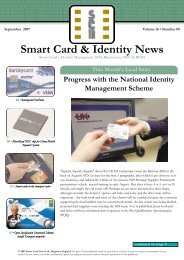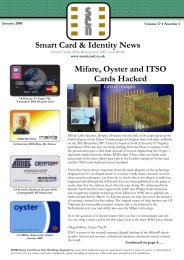Newsletter - June 1997 - Smart Card News
Newsletter - June 1997 - Smart Card News
Newsletter - June 1997 - Smart Card News
Create successful ePaper yourself
Turn your PDF publications into a flip-book with our unique Google optimized e-Paper software.
<strong>Smart</strong> <strong>Card</strong> Tutorial<br />
Right:<br />
Figure 4<br />
The Digital Signature<br />
Right:<br />
Figure 5<br />
Generating a<br />
Cryptographic<br />
Check Value<br />
This cipher, produced with the transmitters secret key,<br />
is usually referred to as a digital signature. However the<br />
process that we have described so far is actually<br />
incomplete since the checking of a digital signature<br />
requires an element of redundancy. In simple terms we<br />
could send the complete message in plain-text as well as<br />
the digital signature. The redundancy is then observed<br />
by checking the decoded signature data against the plaintext<br />
message data. Imagine for a minute that the message<br />
data is a random number then the receiver has no way<br />
of knowing if this is the true random number without<br />
being sent additional information, in this case a total copy<br />
of the false cipher block. It is only by comparing the<br />
decoded signature with the plain text data that the receiver<br />
can be assured of the authenticity of the data. This same<br />
process therefore achieves three properties:<br />
1 The integrity (correctness) of the data<br />
2 The authenticity of the source<br />
3 Non-repudiation in that the transmitter cannot subsequently<br />
deny the operation<br />
We should note here that the symmetric algorithm cannot<br />
achieve these same properties because the transmitter<br />
and receiver must share the same secret key. Clearly nonrepudiation<br />
is not possible because either party could<br />
have generated the message. Source authentication is<br />
however achieved between corresponding parties. Data<br />
integrity can be assured by developing a cryptographic<br />
check value (CCV) which is sent with the message. The<br />
CCV is sometimes referred to as a message authentication<br />
code. This can be implemented as shown in figure 5. The<br />
cryptographic check value was widely used to protect<br />
the integrity of financial messages where the property<br />
of non-repudiation between correspondent banks was<br />
not a priority. Today with electronic commerce the<br />
situation has totally changed and this latter property is<br />
has become a fundamental requirement.<br />
David Everett<br />
Next week - Security continued.<br />
118<br />
<strong>Smart</strong> <strong>Card</strong> <strong>News</strong> <strong>June</strong> <strong>1997</strong>
















